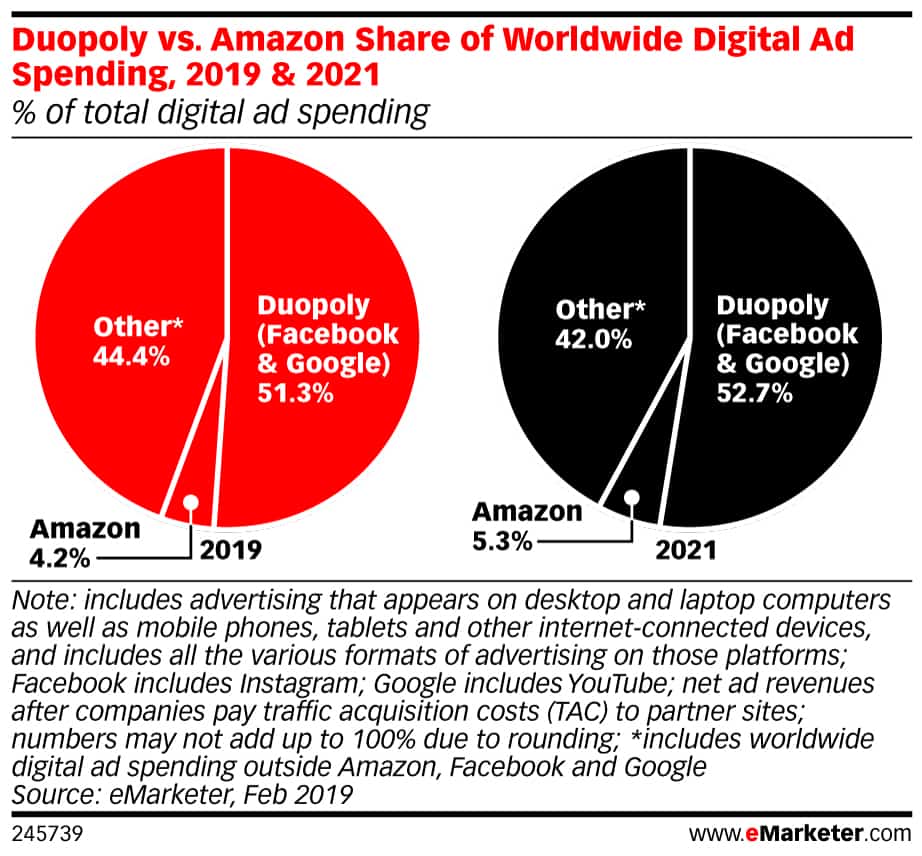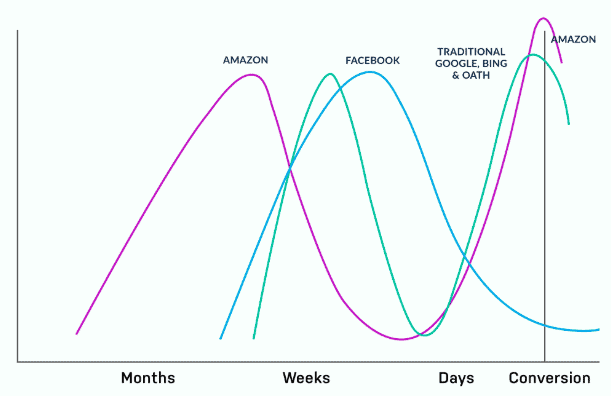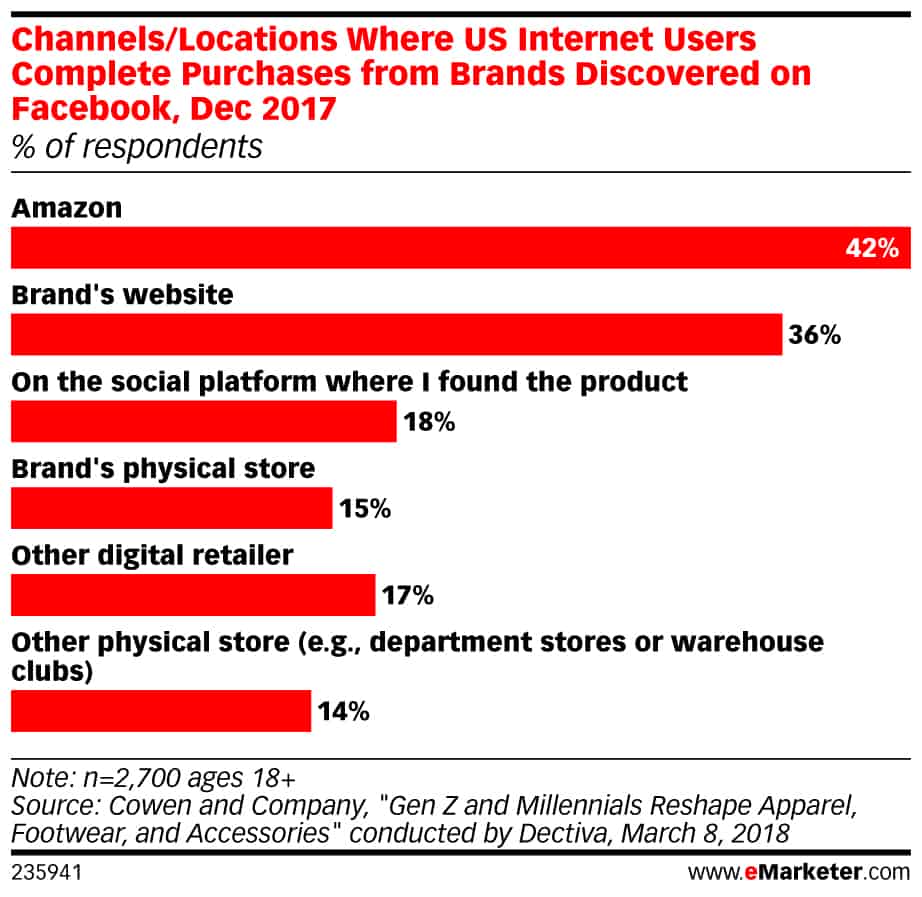
Nich Weinheimer
Vice President, Ecommerce @ Skai

Nich Weinheimer
Vice President, Ecommerce @ Skai
Brands are bullish on advertising with Amazon. But how does it fit into a broader cross channel product advertising program that includes search and social?
Product advertising reached a key milestone in 2018: more than half of all product searches on the internet now take place on Amazon. And as the chart below shows, marketers are beginning to shift more of their budgets to the channel as well.

While the growth noted above may seem modest, it doesn’t tell the whole story. Citi Research projects that Amazon’s ad business will grow to $50.6 billion by 2028 from $10.2 billion this year.
Still, as you can plainly see, the highly effective one-two punch of Google and Facebook won’t be going anywhere anytime soon. Which means marketers need to devise a cross-channel product advertising strategy that combines Amazon advertising, search and social to engage consumers and drive action.
Two things make ads on Amazon particularly compelling:
As a result, these ecommerce ads convert at rates typically higher than those of banners or contextual ads on other sites.
Today’s online customer journey, however, is not as simple as it used to be. In addition to searches on ecommerce sites like Amazon, consumers also use traditional search engines, Facebook, Pinterest, and other social networks, switching back and forth between these channels as they meander through the shopping process, moving from inspiration and product discovery to more focused product research and comparison, and finally on to active online shopping.

Visualization of a typical purchase path
As you can see from the chart above, consumers use Amazon, Facebook, and traditional search engines on their path to purchase. They may see audience-targeted Facebook posts, search ads, display ads on Amazon, and other types of exposure-related content. As the customer moves toward conversion chart, they see keyword-targeted, final purchase ads on Google, Amazon, Bing, and others.
You can understand why it makes sense to combine and sync an Amazon advertising strategy with search and social campaigns to create a holistic cross-channel product advertising program. However, things are moving and changing rapidly in this arena, so you have to be willing to be nimble. With that said, here are a couple of practical things you can do now to get the most out of a cross-channel product advertising effort.
New ecommerce budgets are coming into performance advertising, which means you’ll need a holistic approach to customer engagement in order to zero in on your most effective channels.
You can allocate these new budgets directly on Amazon advertising while also evaluating other channels. Be sure to closely examine how your keywords perform on Amazon, as well as on Google and Bing.
We’ve seen clients optimize spend on specific phrases or terms based on CPCs or conversion rates from different channels and publishers. You’ll need to keep tabs on performance and optimize the budget as a whole. Then, in order to move quickly on opportunities, you’ll need up-to-date performance data across publishers, and to ensure the teams that are managing them (if they’re separate) are working together.
Don’t forget about Pinterest, as it is an increasingly important destination for consumers looking for inspiration and ideas. In fact, in a study of consumer journeys related to buying Halloween costumes, searches for related terms peaked on Pinterest in mid-September – nearly six weeks ahead of the holiday itself. You can make this actionable by allocating some performance advertising budget to Pinterest (especially if your product is all about visual appeal) using broader head terms. This will help you connect with customers who are in the product discovery and research phase.
The chart below makes this point abundantly clear: Facebook is hugely influential when it comes to purchases on Amazon, as 42% of consumers who discover brands on the social network are likely to buy on Amazon—even more than those who decide to buy from a brand’s own website (36%).

Admittedly, brands are likely already aware that a lot of traffic to their Amazon product detail pages comes from Facebook. They may not have been able to track it, but they know there is value there and it is having an impact.
Many brands are starting to use Amazon Stores to amplify this effect. Given that Amazon Stores have your brand’s look and feel and allow you to showcase as many products as you’d like without any competitive presence on the page, it’s a perfect destination for traffic-driving efforts from Facebook.
Facebook ads such as Dynamic Product Ads can be used to promote specific products or product groups and drive visitors to your Amazon Stores page. You can then monitor performance by tracking metrics such as daily visitors, page views, and attributed sales.
Ecommerce advertising on Amazon is becoming an important part of the digital marketing ecosystem. And if you are already advertising on Amazon, you should be looking for ways to maximize its effectiveness by integrating it into your overall digital marketing strategy.
Need help putting it all together? Contact us for a demo today and we’ll help you design a complete cross-channel product advertising program.
Learn More About Skai Ecommerce
We use cookies on our website. Some of them are essential, while others help us to improve this website and your experience.
Here you will find an overview of all cookies used. You can give your consent to whole categories or display further information and select certain cookies.